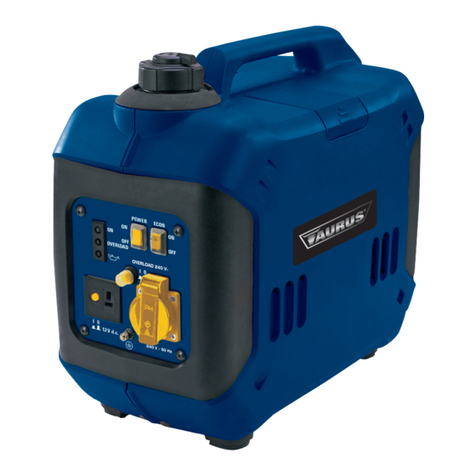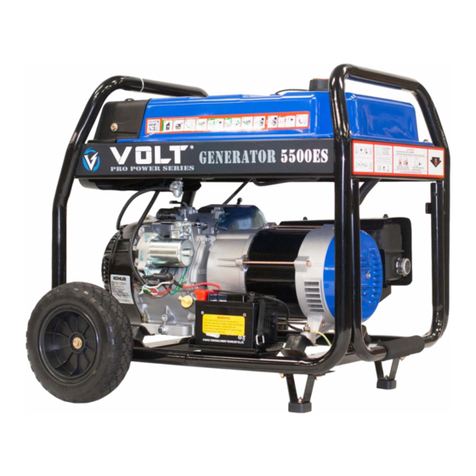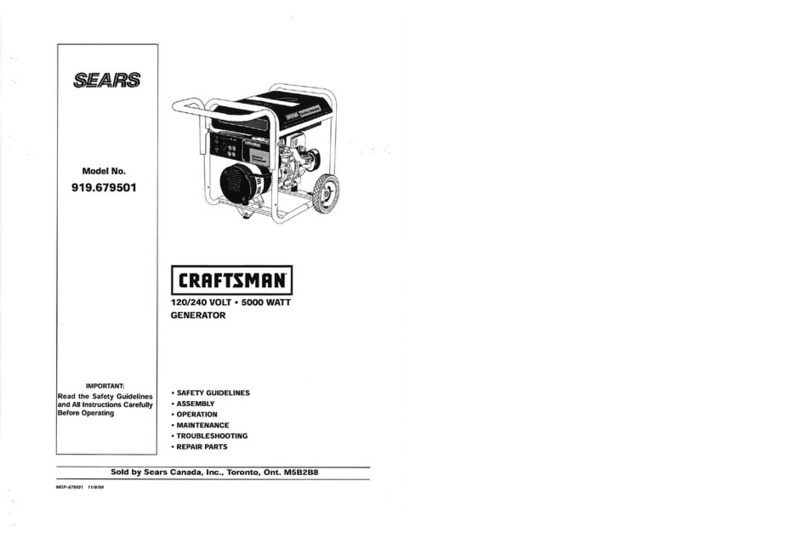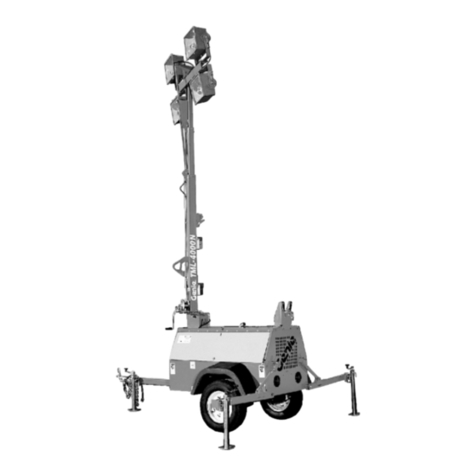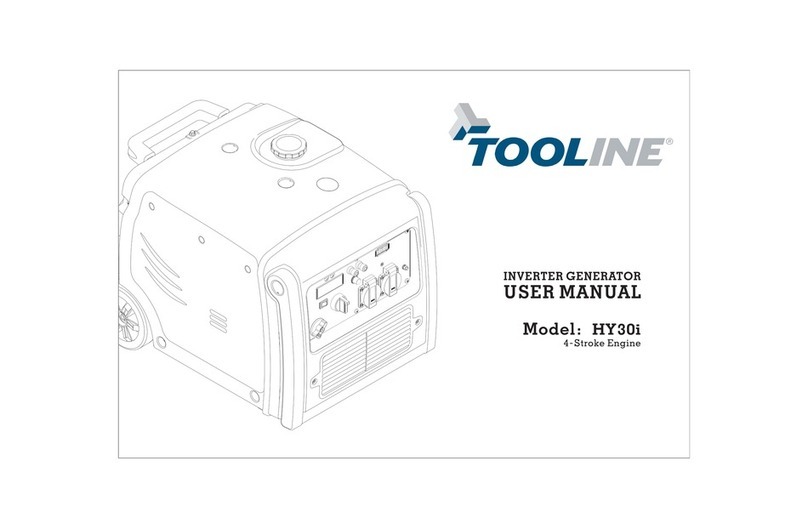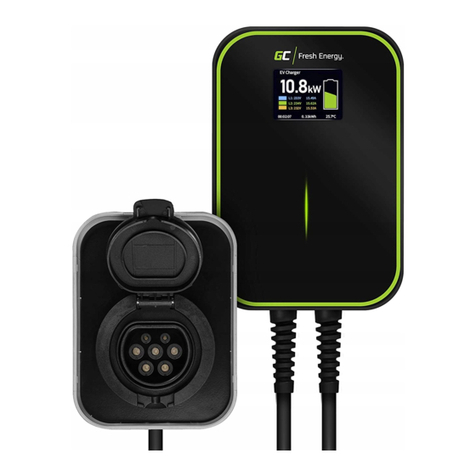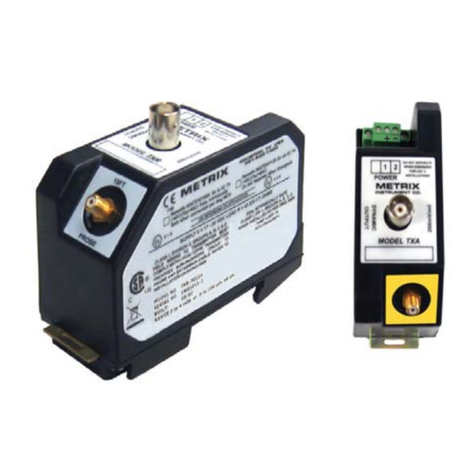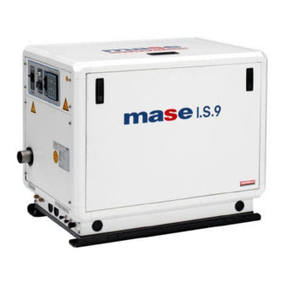Taurus BT-PG 2000/1 User manual

N26704
2200W
PETROL GENERATOR
INSTRUCTION MANUAL
AFTER SALES SUPPORT
TEL: 1300 922 271
EMAIL: [email protected]
MODEL NUMBER BT-PG 2000/1

Petrol Generator
What your 2 year warranty means
Great care has gone into the manufacture of this product and it should therefore provide you with years
of good service when used properly. In the event of product failure within its intended use over the
course of the rst 2 years after the date of purchase, we will remedy the problem as quickly as possible
once it has been brought to our attention. In the unlikely event of such an occurrence, or if you require
any information about the product, please contact us via our after sales support services, details of
which can be found in this manual and on the product itself.
Welcome Section
Congratulations on choosing to buy a TAURUS® product.
All products brought to you by TAURUS® are manufactured to the highest standards of performance and
safety, and, as part of our philosophy of customer service and satisfaction, are backed by our
comprehensive 2Year Warranty.
We hope you will enjoy using your purchase for many years to come.
Table of Contents
1. Safety regulations
2. Layout and items supplied
3. Proper use
4. Technical data
5. Before starting the machine
6. Operation
7. Cleaning, maintenance and ordering of spare parts
8. Disposal and recycling
2

GENERAL SAFETY RULES
SAVE THESE INSTRUCTIONS
1. Work area
a. Keep work area clean and well lit. Cluttered and
dark areas invite accidents.
b. Do not operate power tools in explosive
atmospheres, such as in the presence of
ammable liquids, gases or dust. Power tools
create sparks which may ignite the dust or fumes.
c. Keep children and bystanders away while
operating a power tool. Distractions can cause
you to lose control.
2. Electrical safety
a. Power tools plugs must match the outlet.
Never modify the plug in any way. Do not use
any adapter plugs with earthed (grounded)
power tool. Unmodied plugs and matching
outlets will reduce risk of electric shock.
b. Avoid body contact with earthed or grounded
surfaces such as pipes, radiators, ranges and
refrigerators. There is an increased risk of electric
shock if your body is earthed or grounded.
c. Do not expose power tools to rain or wet
conditions. Water entering a power tool will
increase the risk of electric shock.
d. Do not abuse the cord. Never use the cord
for carrying, pulling or unplugging the power
tool. Keep cord away from heat, oil, sharp edges
or moving parts. Damaged or entangled cords
increase the risk of electric shock.
e. When operating a power tool outdoors, use an
extension cord suitable for outdoor use. Use of
a cord suitable for outdoor use reduces the risk
of electric shock.
3. Personal safety
a. Stay alert, watch what you are doing and use
common sense when operating a power tool. Do
not use a power tool while you are tired or under
the inuence of drugs, alcohol or medication. A
moment of inattention while operating power
tools may result in serious personal injury.
b. Use safety equipment. Always wear eye
protection. Safety equipment such as dust
mask, non-skid safety shoes, hard hat, or hearing
protection used for appropriate conditions will
reduce personal injuries.
c. Avoid accidental starting. Ensure the switch is in
the off-position before plugging in. Carrying
power tools with your nger on the switch or
plugging in power tools that have the switch on
invites accidents.
d. Remove any adjusting key or wrench before
turning the power tool on. A wrench or a key left
attached to rotating part of the power tool may
result in personal injury.
e. Do not overreach. Keep proper footing and
balance at all times. This enables better control
of the power tool in unexpected situations.
f. Dress properly. Do not wear loose clothing or
jewellery. Keep your hair, clothing and gloves
away from moving parts. Loose clothes,
jewellery or long hair can be caught in moving
parts.
g. If devices are provided for the connection of
dust extraction and collection facilities, ensure
these are connected and properly used. Use of
these devices can reduce dust-related hazards.
4. Power tool use and cars
a. Do not force the power tool. Use the correct
power tool for your application. The correct
power tool will do the job better and safer at the
rate for which it was designed.
b. Do not use the power tool if the switch does not
turn it on and off. Any power tool that cannot be
controlled with the switch is dangerous and must
be repaired.
c. Disconnect the plug from the power source and/
or the battery pack from the power tool before
making any adjustments, changing accessories,
or storing power tools. Such preventive safety
measures reduce the risk of starting the power
tool accidentally.
d. Store idle power tools out of the reach of
children and do not allow persons unfamiliar
with the power tool or these instructions to
operate the power tool. Power tools are
dangerous in the hands of untrained users.
e. Maintain power tools. Check for misalignment
or binding of moving parts, breakage of parts
and any other condition that may affect the
power tools operation. If damaged, have the
power tool repaired before use. Many accidents
are caused by poorly maintained power tools.
f. Keep cutting tools sharp and clean. Properly
maintained cutting tools with sharp cutting
edges are less likely to bind and are easier to
control.
g. Use the power tool, accessories and tool bits
etc. in accordance with these instructions and
in the manner intended for the particular type
of power tool, taking into account the working
conditions and the work to be performed. Use of
the power tool for operations different from
those intended could result in a hazardous
situation.
5. Service
a. Have your power tool serviced by a qualied
repair person using only identical replacement
parts. This will ensure that the safety of the
power tool is maintained.
5
WARNING! Read all instructions Failure to
follow all instructions listed below may result
in electric shock, re and/or serious injury. The
term ’’power tool’’ in all of the warnings listed
below refers to your mains-operated (corded)
power tool or battery-operated (cordless) power
tool.

Important!
When using the equipment, a few safety
precautions must be observed to avoid injuries
and damage. Please read the complete operating
instructions and safety regulations with due care.
Keep this manual in a safe place, so that the
information is available at all times. If you give the
equipment to any other person, hand over these
operating instructions and safety regulations as
well. We cannot accept any liability for damage
or accidents which arise due to a failure to follow
these instructions and the safety instructions.
Explanation of the warning signs on the machine
(Fig. 9)
1. Important. Read the operating instructions.
2. Important. Hot parts. Keep your distance.
3. Important. Switch off the engine before
refueling.
4. Important. Never operate in non-ventilated
rooms.
1. General safety instructions:
• No changes may be made to the generator.
• Only original parts may be used for
maintenance and accessories.
• Important: Danger of poisoning, do not inhale
emissions.
• Children are to be kept away from the
generator.
• Important: Risk of burns. Do not touch the
exhaust system or drive unit.
• Wear suitable ear protection when in the
vicinity of the equipment.
• Important: Petrol and petrol fumes are highly
combustible or explosive.
• Never operate the generator in non-ventilated
roomsorineasilyinammableadjacency.
When operating the generator in rooms with
good ventilation, the exhaust gases must
be channeled directly outdoors through an
exhaust hose. Important: Toxic exhaust gases
can escape despite the exhaust hose. Due to
therehazard,neverdirecttheexhausthose
towardsinammablematerials.
• Risk of explosion: Never operate the generator
in rooms with combustible materials.
• The speed preset by the manufacturer is not
allowed to be changed. The generator or
connected equipment may be damaged.
• Secure the generator against shifting and
toppling during transport.
• Place the generator at least 1m away from
buildings and the equipment connected to it.
• Place the generator in a secure, level position.
• Do not turn, tip or change the generator’s
position while it is working.
• Always switch off the engine when
transporting and refueling the generator.
• Make sure that when you refuel the
generator no fuel is spilt on the engine or
exhaust pipe.
• Never operate the generator in rain or snow.
• Never touch the generator with wet hands.
• Guard against electric danger. When
working outdoors, use only extension cables
that are approved for outdoor use and
which are marked accordingly (H07RN..).
• The overall length of the extension cables
used may not exceed 50 m for 1.5 mm2 and
100 m for 2.5 m2.
• No changes may be made to the settings of
the motor or generator.
• Repairs and adjustment work may only be
carried out by authorised trained personnel.
• Do not refuel or empty the tank near open
lights,reorsparks.Donotsmoke!
• Do not touch any mechanically driven or hot
parts. Do not remove the safety guards.
• Do not expose the tools to damp or dust.
• Permissible ambient temperature – 10 to +
40 °C, max. altitude above sea level 1000 m,
relative humidity: 90 % (non-condensing)
• The generator is driven by a combustion
engine, which produces heat in the area of
the exhaust (on the opposite side of the
sockets) and the exhaust outlet. You should
therefore keep clear of these surfaces
because of risk of skin burns.
• The values quoted in the technical data
for sound power level (LWA) and sound
pressure level (LWM) are emission values
and not necessarily reliable workplace
values. As there is a correlation between
emission and immission levels, the values
are not a reliable basis for deciding on
any additional precautions which may be
needed.Factorsinuencingtheactualuser
immission level include the properties of
the work area, other sound sources etc., the
number of machines and other processes
in the vicinity, as well as the time span in
which the operator is subjected to the noise.
Also, the permitted immission level can vary
from country to country. Nevertheless, with
this information the user is able to make a
better assessment of the dangers and risks
involved.
• Never use a faulty or damaged electrical
equipment (this also applies to extension
cables and plug connections).
6

7
Risk of electrocution and re
Hazard What could happen How to prevent it
Improper storage of extension
cord.
Extension cord can come into
contact with hot engine parts
resulting in damage. Using a
damaged extension cord can
result in electrocution or death.
Remove extension cord from the
generator and store separately
away from generator.
Operation of generator in rain,
wet, icy, or ooded conditions.
Water is an excellent
conductorofelectricity!Water
which comes in contact with
electrically charged components
can transmit electricity to the
frame and other surfaces,
resulting in electrical shock to
anyone contacting them.
Operate generator in a clean,
dry, well ventilated area. Make
sure hands are dry before
touching unit.
Placing generator on or against
highly conductive surface, such
as a steel walkway or metal roof.
Accidental leakage of electrical
current could charge
conductive surfaces in contact
with the generator.
Place generator on low
conductivity surface such as a
concrete slab.
ALWAYS operate generator a
minimum of 2 meters from any
conductive surface.
Use of worn, damaged or
ungrounded extension cords.
Contact with worn or damaged
extension cords could result in
electrocution.
Use of ungrounded cordsets
could prevent operation of
circuit breakers and result in
electrical shock.
Inspect extension cords before
use and replace with new cord if
required.
Always use a cordset having a
grounding wire with an
appropriate grounding plug. DO
NOT use an ungrounded plug.
Operation of unit when
damaged, or with guards or
panels removed.
Attempting to use the unit when
it has been damaged, or when it
is not functioning normally could
resultinreorelectrocution.
Removal of guarding could
expose electrically charged
components and result in
electrocution.
Do not operate generator with
mechanical or electrical problem.
Have unit repaired by an
Authorised Service Centre.
Do not operate generator with
protective guarding removed.

8
Risk of re
Hazard What could happen How to prevent it
Attempting to ll the fuel tank
while the engine is running.
Fuel and fuel vapours can
become ignited by coming in
contact with hot components
suchasthemufer,engine
exhaust gases, or from an
electrical spark.
Turn engine off and allow it to
cool before adding fuel to the
tank. Equip area of operation
withareextinguishercertied
tohandlegasolineorfuelres.
Sparks, re, hot objects Cigarettes,sparks,res,orother
hot objects can cause fuel or fuel
vapours to ignite.
Add fuel to tank in well
ventilated area. Make sure there
are no sources of ignition near
the generator.
Improper storage of fuel Improperly stored fuel could lead
to accidental ignition. Fuel
improperly secured could get
into the hands of children or
otherunqualiedpersons.
Store fuel in an approved
container designed to hold fuel.
Store container in secure location
to prevent use by others.
Tampering with factory set
engine speed settings.
Engine speed has been factory
set to provide safe operation.
Tampering with the engine speed
adjustment could result in
overheating of attachments and
couldcauseare.
Never attempt to “speed-up” the
engine to obtain more
performance. Both the output
voltage and frequency will be
thrown out of standard by this
practice, endangering
attachments and the user.
Inadequate ventilation for
generator
Materials placed against or near
the generator or operating the
generator in areas where the
temperature exceeds 40°C.
ambient (such as storage rooms
or garages) can interfere with
its proper ventilation features
causing overheating and pos-
sible ignition of the materials or
buildings.
Operate generator in a clean,
dry, well ventilated area.
DO NOT OPERATE UNIT
INDOORS OR IN ANY CONFINED
AREA.
Overlling the fuel tank – fuel
spillage.
Spilled fuel and its vapours can
become ignited from hot
surfaces or sparks.
Usecareinllingthetankto
avoid spilling fuel. Make sure fuel
cap is secured tightly and check
engine for fuel leaks before
starting engine. Move generator
away from refuelling area or any
spillage before starting engine.
Allow for fuel expansion. Never
refuel with the engine running.

9
Risk of injury and property damage when transporting generator
Hazard What could happen How to prevent it
Fire, inhalation, damage to
vehicle surfaces
Fuel or oil can leak or spill and
couldresultinreorbreathing
hazard,seriousinjuryordeath
can result. Fuel or oil leaks can
damage carpet, paint or other
surfaces in vehicles or trailers.
The generator is equipped with a
fuel drain valve, turn the valve to
the off position before
transporting to avoid fuel leaks.
Transport fuel only in an
approved fuel container. Always
place generator on a protective
mat when transporting to protect
against damage to vehicle from
leaks. Remove generator from
vehicle immediately upon arrival
at your destination.
Risk of breathing – inhalation hazard
Hazard What could happen How to prevent it
Gasoline engines produce toxic
carbon monoxide exhaust fumes.
Breathing exhaust fumes will
cause serious injury or death.
Operate generator in clean, dry,
well ventilated area. Never
operate unit in enclosed areas
such as garages, basements,
storage, sheds, or in any location
occupied by humans or animals.
Keep children, pets and others
away from area of operating unit.
Risk of unsafe operation
Hazard What could happen How to prevent it
Operation of generator in
careless manner.
All sources of energy include
the potential for injury. Unsafe
operation or maintenance of your
generator could lead to serious
injury or death to you or others.
Review and understand all of the
operating instructions and
warnings in this manual.
• Become familiar with the
operation and controls of
the generator. Know how to
shut it off quickly.
• Equip area of operation
withareextinguisher
certiedtohandlegasoline
orfuelres.
• Keep children or others
away from the generator at
all times.
Operating generator while
suspended
Generator will not operate
properly and will cause damage
to the generator and could cause
serious injury or death to you or
others.
Never operate generator while
suspended or in an unlevel
position. Always operate
generatoronaat,levelsurface.

CAUTION!
Read all safety regulations and instructions.
Any errors made in following the safety regulations
andinstructionsmayresultinanelectricshock,re
and/or serious injury.
Keep all safety regulations and instructions in a
safe place for future use.
2. Layout (Fig. 1/4)
1. Tank indicator
2. Tank cover
3. 2 x 240 V~ socket-outlets
4. Earth connection
5. Overload cut out switch
6. Voltmeter
7. Oilllerplug
8. Oil drain plug
9. Oil shortage cut-out
10. On/Off switch
11. Choke lever
12. Reversing starter
13. Petrol cock
3. Proper use
The device is designed for applications operated
with a 240 V alternating current source. Be sure to
observe the restrictions in the safety instructions.
The generator is intended to provide electric tools
and light sources with electricity.
When using the device with household appliances,
please check their suitability in accordance with the
relevant manufacturer’s instructions. In case of
doubt,askanauthorizeddealeroftherespective
appliance.
The machine is to be used only for its prescribed
purpose. Any other use is deemed to be a case of
misuse. The user / operator and not the
manufacturer will be liable for any damage or
injuries of any kind caused as a result of this.
Please note that our equipment has not been
designed for use in commercial, trade or industrial
applications. Our warranty will be voided if the
machine is used in commercial, trade or industrial
businesses or for equivalent purposes.
4. Technical data
Generator: Synchronous
Protection type: IP23
Continuous rated power Prated (S1): 2000 W
Maximum power Pmax (S2 2 min): 2200 W
Rated voltage Urated: 2 x 240V~
Rated current Irated: 8.7 A
Frequency Frated: 50Hz
Drive engine design: 4-stroke, air-
cooled
Displacement: 196 cm3
Max. power: 3.74 kW /
5 hp
Fuel: Unleaded
Tank capacity: 15 L
Engine oil: SAE #30
Consumption at 2/3 load: approx. 1.1
l/h
Weight: 39.1 kg
Sound pressure level LpA: 71.6 dB(A)
Sound power level LWA/Uncertainty K: 94 dB
(A)/1.9
dB(A)
Power factor cosφ: 1
Protection type: IP23
Power class: G1
Max. temperature: 40°C
Max. altitude (above mean sea level): 1000 m
Spark plug: F6 RTC
Operating mode S1 (continuous operation)
The machine can be continuously operated with
the quoted power output.
Operating mode S2 (temporary operation)
The machine may be temporarily operated
with the quoted power output. Afterwards the
machine must be stopped for a while to prevent
it from overheating.
3. Before putting the
machine into operation
5.1 Electrical safety:
• Electric supply cables and connected
equipment must be in perfect condition.
• The generator is to be operated
only with equipment whose voltage
specicationsconformwiththegenerator’s
output voltage.
10

m
• Never connect the generator to the power
supply (socket-outlet).
• Keep the cable length to the consumer as
short as possible.
5.2 Environmental protection
• Dispose of soiled maintenance material
and operating materials at the appropriate
collection point.
• Recycle packaging material, metal and
plastics.
5.3 Connecting to earth
The housing is allowed to be connected to earth
in order to discharge static electricity. To do this,
connect one end of a cable to the earth
connection on the generator (Fig. 4) and the
other end to an external earth (for example an
earthing rod).
6. Operation
Important!Youmustllupwithengineoil
(approx. 0.6 l) and fuel before you can start the
engine.
• Check the fuel level and top it up if
necessary
• Makesurethatthegeneratorhassufcient
ventilation
• Make sure that the ignition cable is secured
to the spark plug
• Inspect the immediate vicinity of the
generator
• Disconnect any electrical equipment which
may already be connected to the generator
6.1 Starting the engine
• Open the petrol cock (13) by turning it down
• Move the ON/OFF switch (10) to position
“ON”.
• Move the choke lever (11) to position IØI.
• Start the engine with the reversing starter
(12) by pulling the handle forcefully. If the
engine does not start, pull the handle again.
• Push the choke lever (11) back again after
the engine has started.
Important! When starting with the reserve
starter, the motor may recoil suddenly as it starts
up, resulting in hand injuries. Wear protective
gloves when starting the equipment.
6.2 Connecting consumers to the generator
• Connect the equipment you want to use to
the 240 V~sockets (3)
Important: These sockets may be loaded
continuously (S1) with 2000W and temporarily
(S2) for a maximum of 2 minutes with 2200W.
• The generator is suitable for 240 V~ AC
appliances.
• Do not connect the generator to the
domestic power network as this may result
in damage to the generator itself or to other
electrical appliances in your home.
Note: Some electrical appliances (power jigsaws,
drills, etc.) may have a higher level of power
consumptionwhenusedindifcultconditions.
6.3 Switching off the engine
• Before you switch off the generator, allow
ittorunbrieywithnoconsumerssothatit
can “cool down”
• Move the ON/OFF switch (10) to position
“OFF” with the key.
• Close the petrol cock
Important! The generator is tted with an
overload cut-out.
This shuts down the sockets (3). You can restart
the sockets (3) by pressing the overload cut-out
(5).
Important! If this happens, reduce the electric
power you are taking from the generator or
remove any defective connected appliances.
Important! Defective overload cut-outs must be
replaced only by overload cut-outs of identical
design and with the same performance data. If
repairs are necessary, please contact your
customer service center.
7. Cleaning, maintenance
and ordering of spare
parts
Switch off the motor and pull the spark plug boot
from the spark plug before doing any cleaning and
maintenance work on the equipment.
Important: Switch off the machine immediately
and contact your service station:
• In the event of unusual vibrations or noise
• If the engine appears to be overloaded or
• misres
7.1 Cleaning
• Keep all safety devices, air vents and the
motor housing free of dirt and dust as far as
possible.
11

m
• Wipe the equipment with a clean cloth or blow
it with compressed air at low pressure.
• We recommend that you clean the device
• immediatelyeachtimeyouhavenishedusing
it.
• Clean the equipment regularly with a moist
cloth and some soft soap. Do not use cleaning
agents or solvents; these could attack the
plastic parts of the equipment. Ensure that no
water can seep into the device.
7.2 Air lter
In this connection, please also read the service
information.
• Cleantheairlteratregularintervals,and
replace it if necessary.
• Open both clips (Fig. 5/A) and remove the air
ltercover(Fig.5/B).
• Removethelterelements(Fig.6/C)
• Do not use abrasive cleaning agents or petrol
to clean the elements.
• Cleantheelementsbytappingthemonaat
• surface.Incasesofstubborndirtrstclean
with soapy water, then rinse with clear water
and airdry.
• Assemble in reverse order
7.3. Spark plug (Fig. 7)
Check the spark plug for dirt and grime after 20
hours of operation and if necessary clean with a
copper wire brush. Thereafter service the spark plug
after every 50 hours of operation.
• Pull off the spark plug boot with a twist.
• Remove the spark plug with the supplied spark
plug wrench.
• Assemble in reverse order
7.4 Changing the oil and checking the oil level
(before using the machine)
The motor oil is best changed when the motor is at
working temperature.
• Only use SAE #30 4 stroke motor oil.
• Place the generator on a slightly inclined
surface so that the oil drain plug is at the lower
end.
• Opentheoilllerplug.
• Open the oil drain plug and let the hot engine
oil drain out into a drip tray.
• After the old oil has drained out, close the oil
drain plug and place the generator on a level
surface again
• Fill in engine oil up to the top mark on the oil
dip stick (approx. 0.6 liters).
• Important: Do not screw the dipstick in to
check the oil level, simply insert it up to the
thread.
• Dispose of the waste oil properly.
7.5 Automatic oil cut-out
The automatic oil cut-out responds if there is
too little oil in the engine. In this case it will not
be possible to start the engine or it will cut out
automatically after a short period of time. It cannot
be started again until the engine oil has been topped
up (see point 7.4).
8. Disposal and recycling
The unit is supplied in packaging to prevent its
being damaged in transit. This packaging is raw
material and can therefore be reused or can be
returned to the raw material system.
The unit and its accessories are made of various
types of material, such as metal and plastic.
Defective components must be disposed of as
special waste. Ask your dealer or your local council.
TAURUS®is a registered trademark of ALDI Stores.
ALDI Guarantee
Specially made for ALDI Stores to our stringent
qualityspecications.Ifyouarenotentirely
satisedwiththisproduct,pleasereturnittoyour
nearest ALDI store within 60 days from the date of
purchase for a full refund or replacement, or take
advantage of our after sales support by calling the
supplier’s Customer Service Hotline.
03/2011
12
Table of contents
Other Taurus Portable Generator manuals
Popular Portable Generator manuals by other brands

Clarke
Clarke WH215 Operation & maintenance instructions
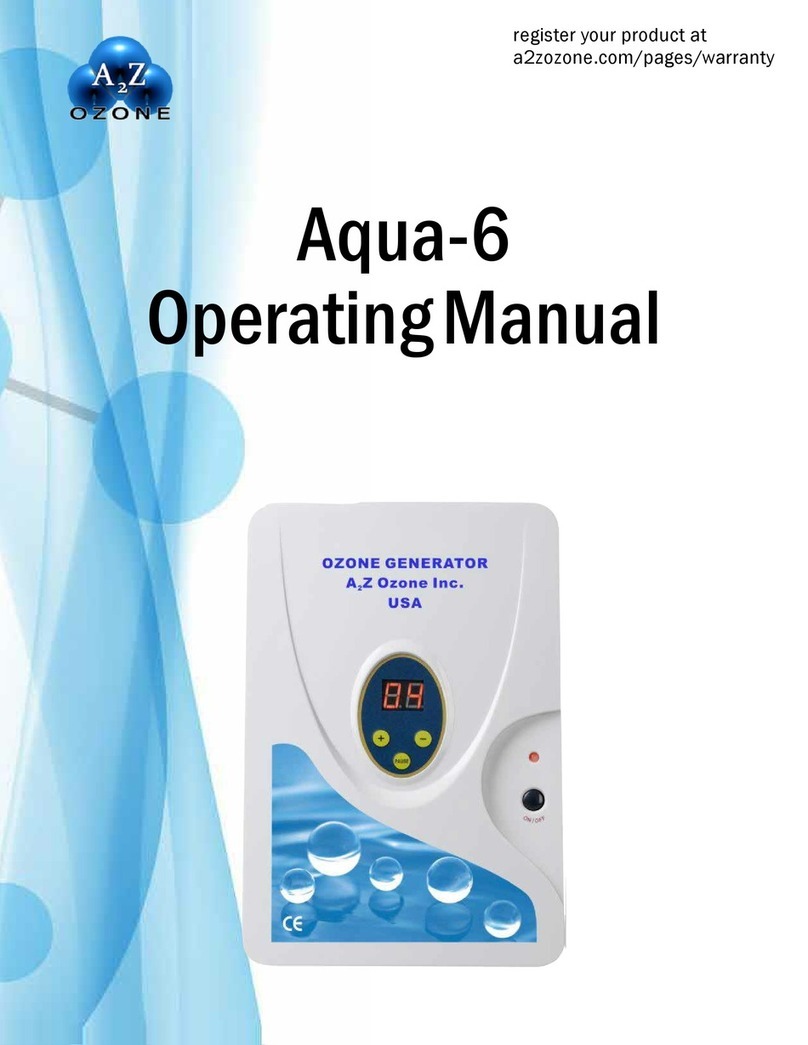
A2Z Ozone Systems
A2Z Ozone Systems Aqua-6 operating manual
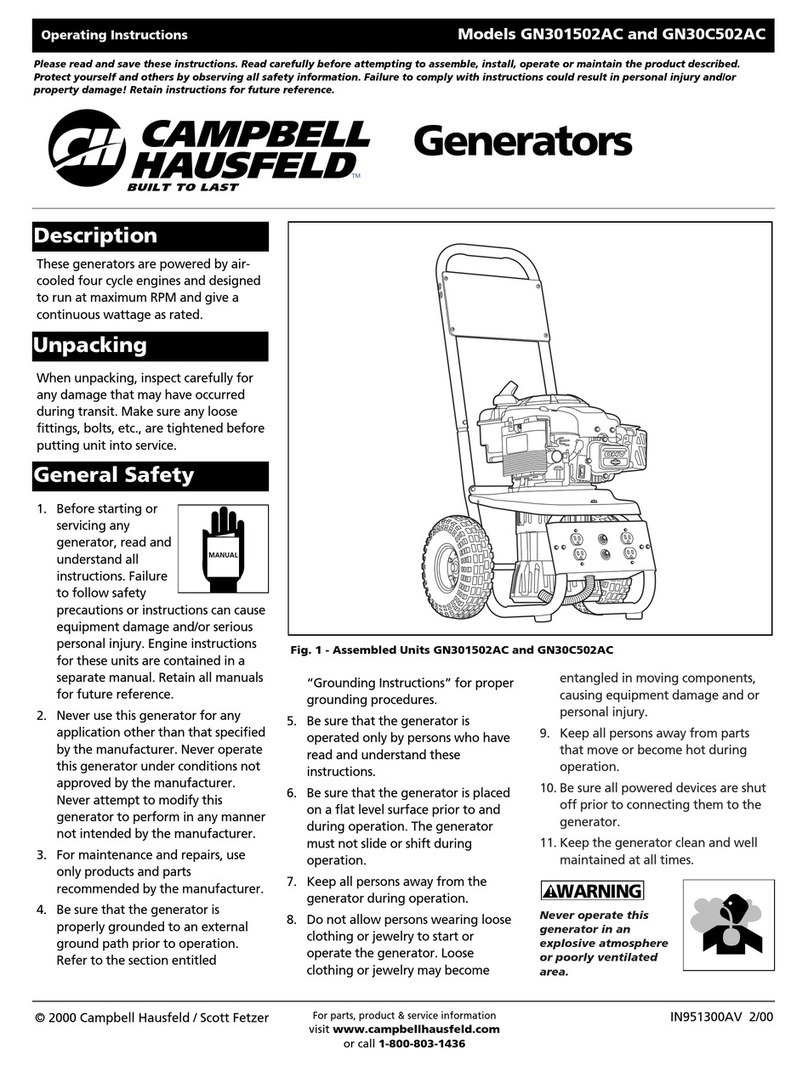
Campbell Hausfeld
Campbell Hausfeld GN30c502AC operating instructions
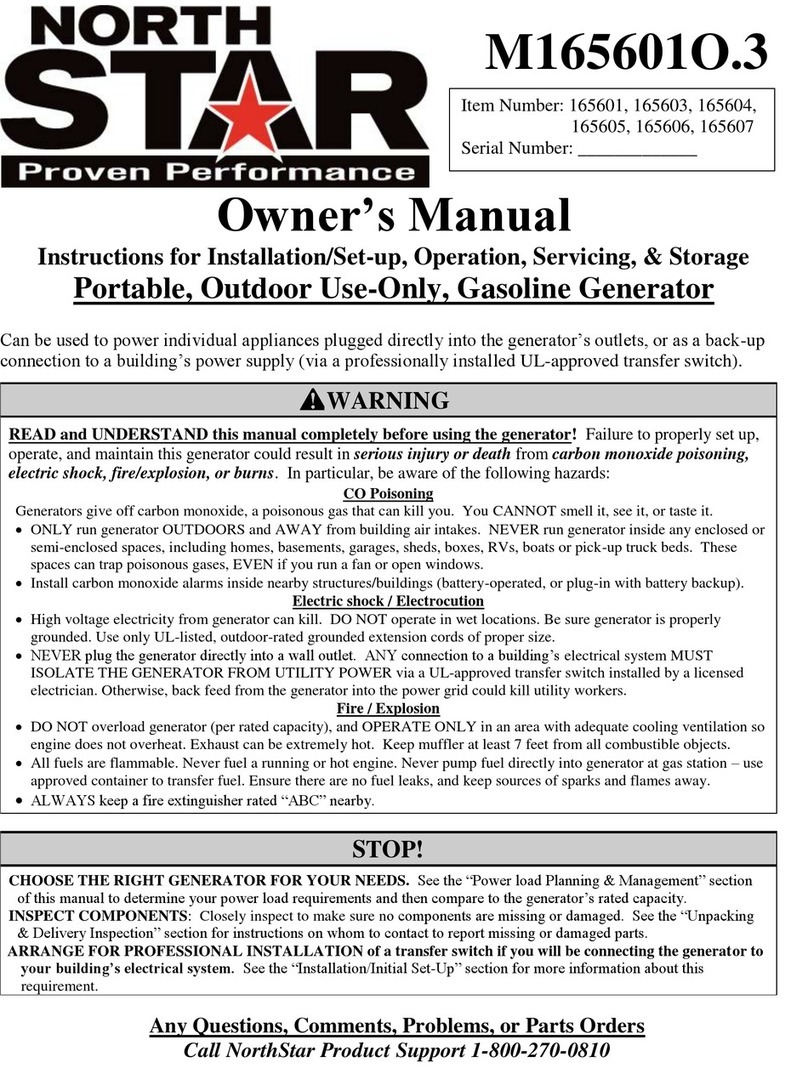
NorthStar
NorthStar 165601 owner's manual

Firman
Firman 1005 owner's manual
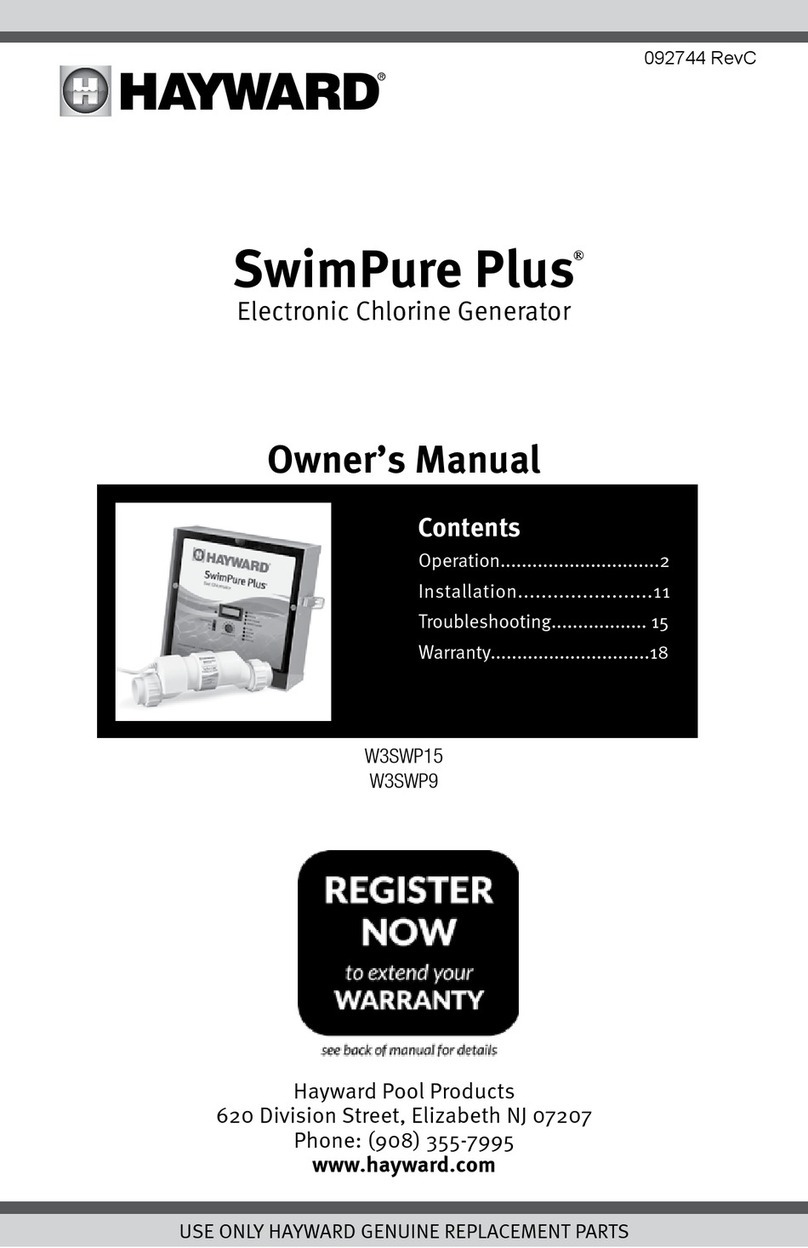
Hayward
Hayward SwimPure Plus W3SWP15 owner's manual


